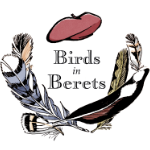
A Diligent Seed Stasher, Suggested by Sam W.
Frequently Photographed
Sam is the sort of birder whose love of birds stems from her deep gratitude and admiration for nearly everything around her. She notices things. Like, really notices. And then she shares them–whether it’s a sunset, frost on her farm in the morning, the steam from a mug, or the same bird that’s visited her feeder without fail all summer, her friends are sure to see pictures. As a birder, I envy her talent for getting a shot of what she’s seeing. Even if it’s just an iPhone camera pressed to one lens of her binoculars, she somehow gets the moment just right. This is why her request for a White-breasted Nuthatch came as no surprise. By the time Birds in Berets began, I almost felt like I knew the little fellow who had been visiting her feeder all summer!
Here he is, to the best of my ability. I didn’t change much. He was already impeccably neat and personable, and I have a suspicion that he may occasionally wear a beret in real life.
White-breasted Nuthatches in Real Life
The White-breasted Nuthatch is an active, social, quirky songbird known for personable movements and frequent bird feeder visits. Unlike woodpeckers, who like to lean on their tails while working methodically from base to top of a tree trunk, nuthatches hop, bob, and twitch in any direction they please. They’re especially well-known for their ability to run straight down tree trunks and along the underside of branches. Their hunting routine usually also includes frequent head tilts and tail twitches, which make them seem so intelligent and exuberant that it’s easy to find oneself imagining their thoughts as they inspect the layers of bark for insects. They’re highly social, keeping in touch with each other through frequent nasal “zzeep!” calls. They’ll often join flocks of other seed-eaters or hole-nesters like kinglets, titmice, chickadees, and small woodpeckers.
Hacking and Stashing
Despite being agile and clever grub-hunters, they get their name for their love of seeds and nuts. Nuthatches often wedge their snack securely in a small crevice where they can crack it open by hammering with their large, upturned bill, rather than using the strength of their jaw alone to open them. This behavior earned them the nickname “nut-hack,” which in time became the common name of the Nuthatch species that live in Europe, and later of their American cousins.
White-breasted nuthatches are frequent visitors to bird feeders offering larger seeds, but many birders see the iconic seed-hacking behavior rarely, if at all. This is because Nuthatches often have other plans for the seed on offer: building up a secret stash for winter. The species is one of North America’s most diligent and crafty when it comes to building and hiding caches of oil-rich survival meals. They’ve been documented carefully varying their flight patterns away from bird feeders in order to confuse and mislead other birds that might be interested in discovering their cache. They’re also masters of camouflage and concealment: because their caches are often large, they spend thought and effort on the grass, moss, bark, or other debris that will cover and obscure the hiding place. They’re also known for using the scent of other, larger animals to deter thieves and predators. After rubbing the entrance to the nest with bits of fur, feather, or aromatic plants, they’ll often tuck those on or near their cache as well.
Everywhere, All The Time (Except When They’re Not)
North America is home to four Nuthatch species, of which the White-breasted Nuthatch is the most numerous and inhabits the largest range. They’re usually year-round residents in their breeding territories, which can be as far north as Canada’s Boreal Forest and as far south as the Gulf Coast. Their range also spans literally from coast to coast, with three distinct subspecies that occupy approximately equal ranges on the east, west, and middle of the continent. The fact that they’re widespread and usually permanent residents meant that it wasn’t until 2018 that a group of bird banders studying the eastern subspecies realized that large numbers of White-breasted Nuthatches do occasionally travel south from Canada to winter in the northern United States. After several more years of research, the team concluded that these occasional migrations happen approximately every other year, and align with years of poor seed production in the eastern Boreal Forest. Migrations that don’t take place annually and affect only part of the populations of a species are called “interruptions,” and can often shine light on the complicated cycles of growth in the ecosystems that the birds ordinarily inhabit.
My Suggestions for Attracting a Nuthatch Family
Because White-breasted nuthatches are an adaptable species with a wide range, you have a good chance of coaxing one to come visit you. They really can’t resist transferring a large pile of seeds one by one from a public feeder to a private cache, so take advantage of their hoarding tendency by offering large, oil-rich food. Black oil sunflower seeds and suet with sunflower seeds or peanuts are a sure bet. In fact, if you’re just starting a new sunflower seed feeder, there’s a good chance your first visitor will be a little nuthatch on a caching mission!
Good nesting holes are another factor in these birds’ choice of breeding territory, and nest boxes are a well-documented strategy for convincing a nuthatch family to move in. Make sure your box is high enough–White-breasted Nuthatches need a nest cavity at least 15 feet off the ground, and have been known to nest as high as 60 feet–and as always, make sure you match the hole size and design to the bird you want to attract. Keep good drainage to prevent disease, and stay willing to help them clean up any nest mess each year.
Character Design
There’s very little to change to get a perfect nuthatch character. As individuals, their behavior is very uniform. As a species, it’s very distinctive. This drawing was more about simplifying the details of feathers and markings into an image that referenced the crisp agility that defines so much of their personality. Since many of their iconic poses involve being dizzyingly upside-down or sideways, I played with the idea that their berets are somehow anti-gravity, too. I liked the notion of a nuthatch clinging to the bottom of a branch and yet somehow wearing a hat. I like to think that if they did wear hats, their anti-gravity magic would somehow apply to their toppers as well. In the end, though, I went with a downward-facing body and upturned head–as though he had paused for just a fraction of a second to say hello to you.
From a technique standpoint, the simplified, almost art-deco version of a nuthatch had one major challenge: pristine, crunchy white outlines. Using black outlines for the edges of feathers would have added a level of complication that actually isn’t there, and would overall have created a more rumpled appearance than I wanted, so the white margins of the flight feathers had to end crisply against the blue-gray behind them. For watercolorists, this just takes a lot of practice. My best tip is to use a high-quality paper when very crisp white outlining is a priority, and work with the hot-pressed version if the rest of your composition allows it. If you’re confident in managing your water saturation, you can also try creating the edge with a drier brush, and then adding a deeper puddle of paint to the space for a moment. Soak it back up with a damp brush or a piece of towel before it dries or bleeds. With practice, this can create a thin edge of a deeper color at the margin of the painted shape, which helps to contrast against the white edge without actually creating an outline. With that being said, I actually painted this on a scrap of illustration board that already had finger prints on it. There’s a link below to the paper I wish I’d used for this, and that I have used for much of the series. Hopefully you can prepare better than I did whenever you next find yourself painting White-breasted Nuthatches!
More About White-breasted Nuthatches
You can find photos, a range map, and several great audio clips of White-breasted Nuthatches in the Audubon Field Guide.
National Audubon Society also has a good write-up on the discovery of White-breasted Nuthatch interruptions in the eastern U.S.
For more tips on Nuthatch I.D., including telling them apart from their similar-looking cousins, check out this entry from Cornell Lab, and for more on seed-caching strategies, check out this Cornell article.
For the research paper linking Nuthatch migration to biennial cycles in Boreal Forest tree masting, you can visit the journal of the Association of Field Ornithologists.
Watercolor Recommendations
For my watercolor friends, here’s what I would have used for this sketch if I had prepared properly! (No one’s paying me for this recommendation, by the way. I just have strong preferences when it comes to painting gear, and think you should too!)

